Ace cafe with quite a nice ancient monument attached?
- Published
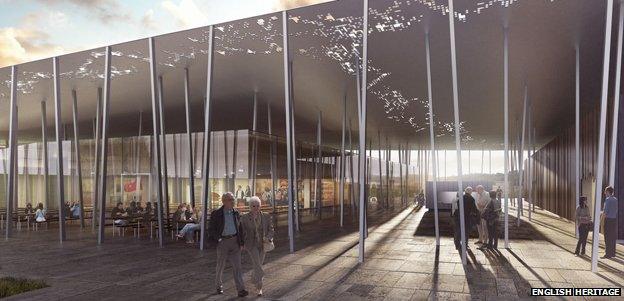
How the new cafe at Stonehenge will look
English Heritage has announced that it is building a £27m visitor centre at Stonehenge, with what looks like a very large eating area. Is the cafe and gift shop almost as important as the attraction itself these days?
Almost 50% of the shiny new visitor centre at Stonehenge will be taken up with a new "bright and spacious" cafe for up to 260 people and a bigger shop.
It almost harks back to a memorable ad campaign by the Victoria and Albert Museum in London. In 1988, the museum commissioned a poster with the slogan: "Where else do they give you £100,000,000 worth of objets d'art free with every egg salad?"
The poster was one of six, all describing the V&A as: "An ace caff, with quite a nice museum attached."
It's a premise that won't surprise anyone who has visited a stately home or garden run by the National Trust recently. Some 19.2 million people made a trip last year. Many of those will have dutifully queued for a flapjack and a cup of tea. Or even a substantial meal.

Scones are a given
Food writer Giles Coren recalls visiting London Zoo as a child and caring more about the gift shop than the animals: "Thousands of school children, coachloads of them have to visit these places, and all they care about is the shop."
He associates past visits to stately homes with rock-hard scones but thinks for many people it's increasingly all about the food. "It's like the Colosseum in Rome, people go all that way to see it only to discover it's a lot of boring old stones, but at least you can get an excellent pizza."
Visitors now demand a nice place to eat, having put up with poor facilities for far too long, Coren suggests. "Everything in Britain has been rubbish for years and people won't put up with it anymore."
There is scepticism among some about the new generation of visitor centres.
TripAdvisor is full of reviews from people who are unimpressed. One reviewer was very upset when changes were made at a cathedral in East Anglia. "I love this cathedral, have been taking visitors to it for over 20 years… but it was so much nicer when you could walk in at the front. Now you have to go through a new visitors' centre, which adds nothing to your experience of visiting the cathedral, but does direct you past a desk for collecting your 'optional' entrance fee."
Another visitor to a major modern art museum in London recalled: "We ordered their vegetable soup - a small bowl with watery soup containing some vegetables and a small hard roll (and we had to ask for some butter!) - 6.50 each! For us that's a rip-off and we were not impressed."
But generally the trend is for the cafes in museums, galleries and castles to get better and better. And those in the heritage business see them as a happy synergy.
"A good shop and cafe greatly enhance the overall experience," says Matthew Tanner, chairman of the Association of Independent Museums. "No visit is complete without an interesting shop, a fine cup of tea, and not forgetting a good loo too."
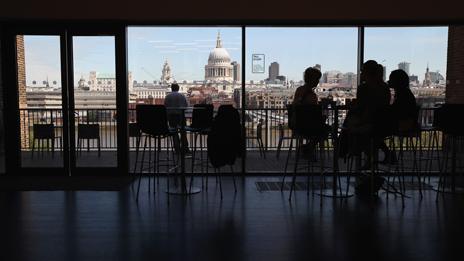
The view from Tate Modern's skyline cafe...
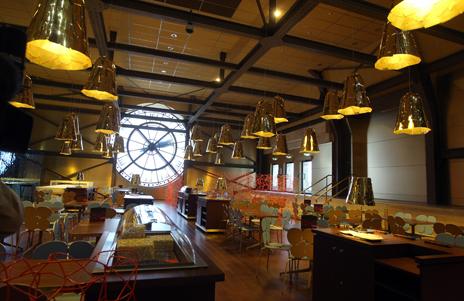
... inside the Orsay Museum's new cafe with added va-va-voom in Paris
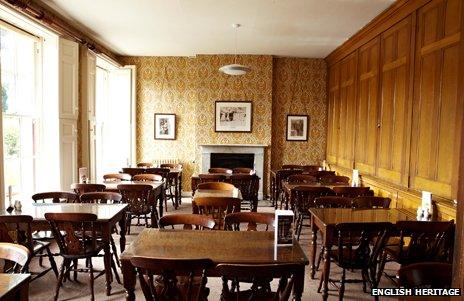
... and a period-appropriate tearoom at Brodsworth Hall in Yorkshire
The argument for spending money on an extensive cafe is twofold - visitors have come to expect them, and the revenue raised helps subsidise the attraction.
One place where this takes place is RHS Wisley in Surrey where the gift shop and cafe are the gatekeepers to the gardens people come to see. Nigel Eaton manages the shop and says it is part of the whole experience.
"We've got three kinds of customers - we have the RHS members who visit on a regular basis, the gardeners who come just for the plants and then we've got what we call the payers, who come on coaches for a nice day out. Every penny that is spent in the shop goes back into the RHS, so the shop is very important to us."
Some 1.1 million people visit Wisley every year. The results of a customer survey revealed that 22% of those visitors came just for the "retail experience". Last year the shop - including one of the world's biggest gardening bookshops - made £3.8m and they expect to make an even bigger profit this year.
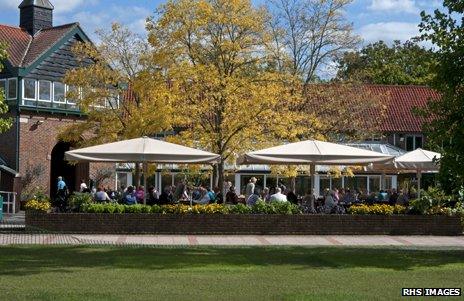
The Conservatory Cafe at Wisley...
As a Lonely Planet author, David Else has visited a lot of tourist attractions and has no problem with visitor centres. In fact he rather likes them.
"In the case of Stonehenge, a good visitor centre is going to tell you so much more about the history of what is essentially a group of old stones. I've got no problem with cafes, either - I like a good cup of tea after a visit and don't mind if they want to make a few bob to help preserve the site."
In the heritage and art business it's all about making attractions "sustainable".
Getting the shop and cafe right at an attraction is a win-win situation, says Jane Temperley from the Association for Cultural Enterprises. "Sure it is about generating income - everyone is looking at how to make their sites more sustainable. But research says visitors enjoy cafes and shops, happy visitors spend more and tend to become repeat visitors or members, which generates more income."
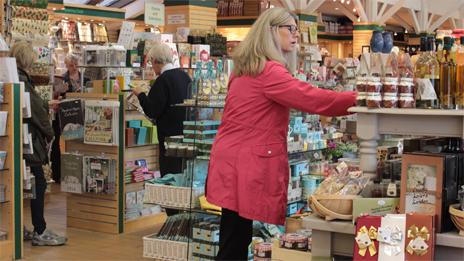
... with a shop selling books, local crafts and chutneys
About 80% of visitors to Wisley are RHS members so they come back to visit time and time again. Thirty-two staff work in the Wisley Shop and 60 staff work in the cafes and restaurants - that's over 25% of the total site staff of 350.
And the staff at attraction are at pains to point out that the food has got better and better. Laurent Trenga is the chef responsible for the planning of menus at Wisley. He points out that a burger and chips at Wisley is no ordinary burger and chips. "Our burger is made from locally sourced quality pork and apples grown in our own orchards, even the bun is made fresh on site."
The plants are rather nice too.
You can follow the Magazine on Twitter, external and on Facebook, external